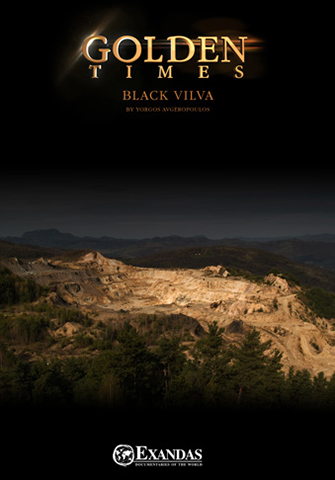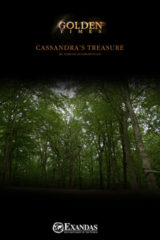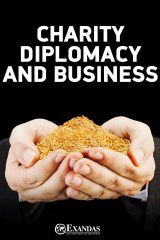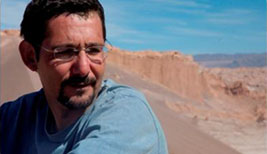
Golden Times – Black Vilva
Dir: Yorgos AvgeropoulosRosia Montana is a village of 4,000 inhabitants, nestled in a green valley in the Carpathian Mountains of Romania, with a 2000-year-long history. Its underground holds a treasure, namely Europe’s largest gold deposit! There are, on the whole, 240 tons of gold, which the Canadian company Gabriel Resources plans to exploit by constructing Europe’s largest opencast gold mine in the area.
The historically high prices of this precious metal make this investment particularly profitable for the company. On the other side, the Romanian state believes that, during this period of global economic crisis, this project will bring development, workplaces and immediate profits of 4 billion dollars.
Despite all this, there are some determined inhabitants, who have been resisting for years, and who believe that Rosia Montana’s true treasure is not its gold. If the realization of the mine requires the residents’ relocation, the environment’s pollution and the destruction of Rosia Montana’s ancient cultural inheritance, who is the one to decide if all this is worth the sacrifice?
Watch the Film Now!
Choose the language you prefer and stream the film in Full HD from any digital device. Enjoy your private screening!
Buy the DVD
Public Screening
Are you interested in organizing a public screening of our film? Send us an email with your inquiry and we will be glad to assist you!
Educational / Library Use
Are you interested in enriching the library of your institution with our film? Contact us and let's create together an informed public!
- DURATION: 51min
- AVAILABLE IN THE FOLLOWING LANGUAGES: English | Romanian | Greek
- AVAILABLE VERSIONS: English (51min) | Romanian (51min) | Greek (51min)
- YEAR OF PRODUCTION: 2011
- Written & Directed by : Yorgos Avgeropoulos
- Producer: Georgia Anagnou
- Production Manager: Anastasia Skoubri
- Director of Photography: Yiannis Avgeropoulos
- Editing: Vasilis Magkos, Anna Prokou
- Original Music: Yiannis Paxevanis
PRODUCTION NOTES
As Rosia Montana’s tradition in metallurgy is lost into the depths of history, its inhabitants have been raised listening to legends about spirits that hide in the mines’ deepest recesses. “The older ones, who used to work at the mines, talk about the White and the Black Vilva. The White Vilva promises you gold, as long as you are willing to share it, whilst, if you are greedy, the Black Vilva will take you somewhere, where nobody can find you”, tells us Calin Capros, an inhabitant of Rosia Montana.
AN UNDERGROUND ACROPOLIS MADE OF ROMAN GALLERIES
Already since the Roman period, Rosia Montana’s wider region is known as the “Golden Quadrilateral”. Its deposits were so rich that according to tradition one could find rocks of gold on the valleys’ surface! In 106 AD, the Romans were the first to found here an entire mining town and build a masterful system of underground galleries, which the archaeologists today compare to an underground acropolis and which allowed them to extract the noble metal that was hidden in the ground. The whole Roman Empire is said to owe an important part of its prosperity to Rosia Montana’s gold.
Later on, throughout all historic periods, Germans, Austrians, Soviets, all wanted to exploit the region’s rich mineral recourses and the traces of this activity are an important part of the world’s cultural heritance. “Whoever studies Law, learns about Rosia Montana, where some waxed tablets were discovered in its underground galleries and which in turn constitute the basis for all those, who study Roman law. Every historian in the world has heard of Rosia Montana!”, says architect Claudia Apostol.
Unfortunately, if these mountains are to be destroyed, the largest part of Rosia Montana’s precious cultural heritage will also be destroyed, since the famous galleries will be blown up. Claudia sadly asks: “In Romania and in Greece we talk about unemployment, but is Greece willing to build a gold mine at the Acropolis, only for the sake of money?”
240 TONS OF GOLD, A HOPE FOR GROWTH DURING A PERIOD OF CRISIS?
Nowadays, the Canadian company, Gabriel Resources, plans to construct Europe’s largest opencast gold mine in Rosia Montana. For the next 16 years, the experts calculate an overall extraction of 240 tons of gold from the earth’s bowels. It is Europe’s largest gold deposit!
In order to proceed with the plans for the mine, Rosia Montana Gold Corporation (RMGC) was founded in 1997 as a union between the Canadian company and the Romanian state. The Canadians own 80,69%, while the remaining 19,31% is under the government’s control, through the state company Minvest. The Romanian state hopes to have an immediate profit of 4 billion dollars from this investment! “It is a project that will create thousands of new positions, since this area has a very high unemployment rate. I would say that 70% of the people have no income, a relatively high percentage”, reminds Catalin Hosu, representative of RMGC.
Through the centuries, the people’s lives in Rosia Montana have always been connected to the gold mine. In recent years, since the mine’s nationalization in 1948 by the communist regime, almost 70% of the people had been working there. After the regime’s fall, the mine was still owned by the state, but it was failing financially and every year it received large subsidies to cover its deficits. Little by little, the working positions became fewer, until 2006, when the mine closed and unemployment struck the region.
“Mining always existed here. Because both my father and brother used to work here and in the future the same will apply. There is no other source of income here. What can you do to survive? Gather mushrooms? There is no other source of income. And we hope that the projects will return, because without them the region is dead”, tells us Nicolae, an inhabitant of Rosia Montana, who had been working in the mineshafts since 1985. “If the project doesn’t start, the majority of the people will have to leave and go to foreign countries, because there are no places to work. You have nothing to do here”, says his fellow villager George.
In today’s Romania of the economic crisis, the population’s percentage that lives below the poverty line reaches 25%, whilst it is estimated that 3 million people have left the country to seek work and a better life abroad. The reopening of Rosia Montana’s mine is being presented as the investment which will stimulate the Romanian economy.
THE RESISTANCE OF A DIFFERENT LOGIC OF DEVELOPMENT
“They think of Rosia Montana’s development only up to the time they extract the gold, while we are thinking about it even after the end of this process. We are thinking about forever, for our generation, but also for our children’s sake and our children’s children sake”, says Eugen David emphatically, one of the mine’s most militant adversaries. He was not born in Rosia Montana, but came here during the 90’s by choice, got married and built his own farm. Today, he is president of the organization “Alburnus Maior”, which was created by those inhabitants, who are determined to oppose the opening of the new mine.
“We are not people, who are against development and the creation of new jobs”, marks Eugen. “It is just that our logic is completely different from that of the company. So, it is only natural that there will be a great conflict between these two choices for development. We believe that ours is the better one”.
Tourism, agriculture and animal husbandry are the alternative forms of development that the inhabitants, who are opposing the mine’s creation, are proposing. However, none of these can be realized, because in 2002 the region was declared an industrial zone by the local administration, where mining is the only activity allowed. So for years now, the communities are living in stranglehold. Their choices include mining on the one hand, or unemployment on the other.
“Everyone was claiming that it is just mining that is taking place and I was annoyed by those saying that after the mining projects were concluded there would be tourism. And why can’t tourism exist now? Is this project needed for tourism to exist?”, asks Andrei. He is 26 years old and his dream was to open a guesthouse and accommodate the tourists that come to this region. Since the region was declared industrial, it was forbidden to build and so he renovated some rooms he had. And in 2008, he realized his dream. Today he makes a living out of this. “They came to Rosia Montana and named it a mining zone, without presenting any other prospects or alternatives and they keep it blocked for all these years. This is financial blackmail”, explains Eugen.
The inhabitants are not the only ones resisting. They are being supported by an unprecedented wave of international solidarity. Many scientists and academics, parties of the European parliament and famous personalities like Vanessa Redgrave and Prince Charles are opposing the company’s plan. Even the World Bank expressed reservations in a 2002 letter to Gabriel Resources by withdrawing its financial support.
HOW A MINE CHANGES THE MAP
“It is the same industrial activity that took place for hundreds of years. People were at the center and made excavations around. For 2,000 years now, this village has had mines. The inhabitants lived here and the mine was situated right next to them, so it is not something unusual”, claims Catalin Hosu of RMGC, in defense of the project. Unfortunately, the company’s own description of the project contradicts his statement.
The four mountains that surround Rosia Montana’s extensive wider region will have to be destroyed and the villages will be surrounded by industrial-scale opencast mines. The whole valley of Corna will be transformed in a tailings disposal basin and a dam, which is planned to hold 250 million tons of toxic substances, will be built.
For this reason, the company’s investment plan provides for the relocation of hundreds of homes that are situated within the impact zone. Approximately 2,000 people, more than half of the village’s inhabitants, have already sold their properties to the company and have left. The village is deserted. “The company came to destroy Rosia Montana in the first place and it has achieved its goal. Before the project has even begun, it destroyed a community that was full of life, full of people. You can see how in the name of a company everything can fall apart”, tells us Sorin Jurka, while he walks through the village’s roads and sadly observes the abandoned houses that are falling apart.
Sorin was born and raised in Rosia Montana. He asks us to visit the village’s cemetery with him. “They even took the dead out of the graves. I think the same numbers of people dead and alive have left the village”, he tells us, while standing over the opened graves. “Every family gets compensated for taking its dead. I believe they want to show who is God here in Rosia Montana”.
CYANIDE AND EUROPE’S SECOND CHERNOBYL
Until now, the project has not yet begun, because the initial Environmental Impact Assessment that the company filed and which is necessary for the project’s authorization, was suspended by the Ministry of Environment and Forests. In September 2007, Mr. Attila Korodi was the minister who found himself in this difficult position. “I am certain that the minerals are a solution for us. But because we are an environmental institution, it is important to apply all the necessary measures for its protection”, he tells us and explains his decision. Of course, the company was not happy and sued Mr. Korodi trying to overturn his decision. Now however, the decision for the new, modified Assessment has still not been made.
The current Minister of the Environment is reasonably cautious, because of a huge environmental disaster that scarred Romania in 2000. In Baia Mare, a city approximately 150 kilometers in the north of Rosia Montana, the dam holding the contaminated waters of a mine, which followed the same methods as those Rosia Montana Gold Corporation in planning, broke. 100,000 cubic meters of cyanide-contaminated waters were spilt in the neighboring river Somes. The contamination crossed the borders, polluting Tiza, Hungary’s second largest river, killing every life-form and destroying the drinking supplies of 2,5 million people.
Anamaria Bogdan was living in Baia Mare, when the accident occurred. “In the beginning, we thought that it was a small, inconsequential accident. However, we soon learned that all of Europe was interested in what happened in Baia Mare, because of the cyanide leek. So, we became famous because of it, but not in a good sense. Baia Mare became Europe’s second Chernobyl”, she tells us.
Nowadays, Hungary, the Czech Republic and Germany are the only European countries that have banned the use of cyanide in mining. In May 2010, the European Parliament issued a directive, with which it recommended the ban of cyanide within the European domain. However, this directive has remained on the European Commission’s shelves and it is in the hands of each state whether to follow it.
“Everybody knows about cyanide and its consequences on the human health. And we know that the Nazis killed the Jews in Auschwitz by using cyanide. But the use of cyanide in mining is a cheaper and more profitable choice for the companies. This is the only thing that matters”, Anamaria points out, and who after her experience in Baia Mare joined the environmental movement.
PRESSURE FOR THE LICENSE AND THE ENVIRONMENT MINISTER’S RESISTANCE
In May 2012, we met with Mr Korodi, who had once again found himself in the difficult position of Minister of Environment. Upon taking office, the county’s President, Mr Basescu, expressed the hope that with the new Minister there will be a quick decision about the natural resources’ exploitation. “He pressures the government to give the permits and anything else that is needed”, says architect Claudia Apostol angrily. “He is, in fact, asking from the government to ignore the laws, to ignore the justice system, to ignore the people’s rights, to ignore everything”.
The company, on the other side, spends a lot of money, in order to convince Romania’s public opinion what a necessary investment for Romania the mine in Rosia Montana is. Most of this money is aimed at manipulating the press. “I can tell you that RMGC is the company with the third largest advertising budget in the country, after the mobile phone companies”, says Mircea Toma, head of the organization ActiveWatch, which monitors how the stories are covered by the Media. “The Media do not often present the ‘cons’. The previous two years, advertisements in favor of gold mining had taken over Romania’s most important Media. I use the term ‘take over’ meaning that they had become visible through these advertisements and you could not find any alternative information that wasn’t provided by them”. Mircea Toma believes that a powerful political and economic lobby has been activated in order to promote the mines and to put pressure on the people responsible. “Everyone is involved, the President, the company, the public opinion… If I were a Minister of Finance, I would think differently, but my part is none other than to think as a Minister of Environment”, says Mr Korodi. The company awaits the Environment Ministry’s last approval in order to proceed with its plans. The Ministry of Culture has already given the necessary permits for the project…
“It will be the final blow. The mining has not stopped for 2,000 years now because Rosia Montana ran out of gold. However, this company will deplete all resources and that will be the final blow. Will they plant new seeds and grow gold? Or do they expect a new ice age, with volcanoes, in order for the soil to regenerate? These are all pipe dreams. There are times in a man’s life, when you have to decide: do you continue to follow this rhythm and die, or do you change strategy?”, Eugen raises this devastating question…







